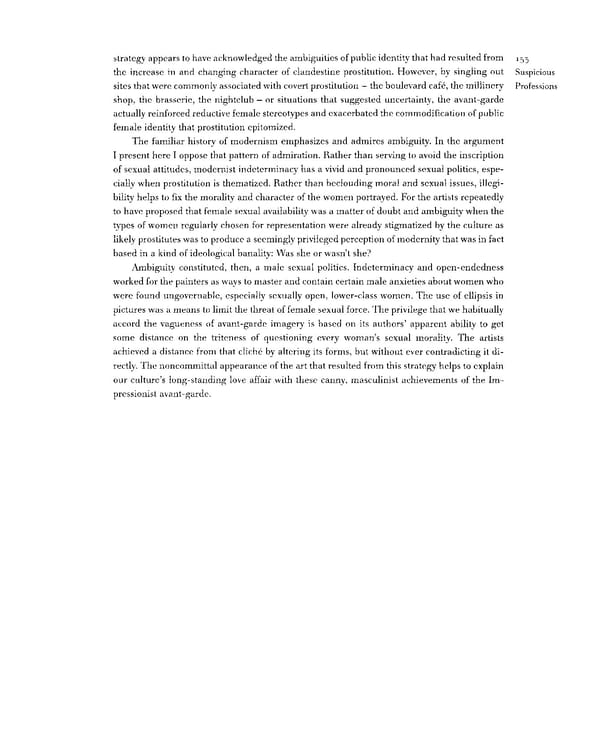strategy appears to have acknowledged the ambiguities of public identity that had resulted from 153 the increase in and changing character of clandestine prostitution. However, by singling out Suspicious sites that were commonly associated with covert prostitution — the boulevard cafe, the millinery Professions shop, the brasserie, the nightclub - or situations that suggested uncertainty, the avant-garde actually reinforced reductive female stereotypes and exacerbated the commodification of public female identity that prostitution epitomized. The familiar history of modernism emphasizes and admires ambiguity. In the argument I present here I oppose that pattern of admiration. Rather than serving to avoid the inscription of sexual attitudes, modernist indeterminacy has a vivid and pronounced sexual politics, espe- cially when prostitution is thematized. Rather than beclouding moral and sexual issues, illegi- bility helps to fix the morality and character of the women portrayed. For the artists repeatedly to have proposed that female sexual availability was a matter of doubt and ambiguity when the types of women regularly chosen for representation were already stigmatized by the culture as likely prostitutes was to produce a seemingly privileged perception of modernity that was in fact based in a kind of ideological banality: Was she or wasn't she? Ambiguity constituted, then, a male sexual politics. Indeterminacy and open-endedness worked for the painters as ways to master and contain certain male anxieties about women who were found ungovernable, especially sexually open, lower-class women. The use of ellipsis in pictures was a means to limit the threat of female sexual force. The privilege that we habitually accord the vagueness of avant-garde imagery is based on its authors' apparent ability to get some distance on the triteness of questioning every woman's sexual morality. The artists achieved a distance from that cliche by altering its forms, but without ever contradicting it di- rectly. The noncommittal appearance of the art that resulted from this strategy helps to explain our culture's long-standing love affair with these canny, masculinist achievements of the Im- pressionist avant-garde.
 Prostitution & Impressionists Page 173 Page 175
Prostitution & Impressionists Page 173 Page 175